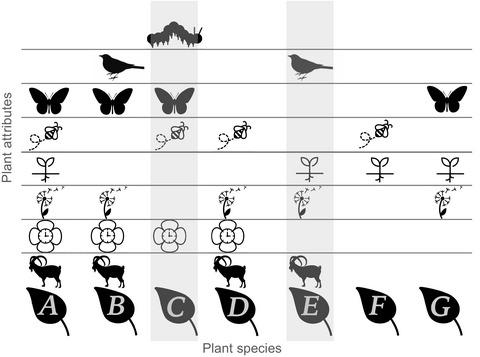当前位置:
X-MOL 学术
›
J. Appl. Ecol.
›
论文详情
Our official English website, www.x-mol.net, welcomes your
feedback! (Note: you will need to create a separate account there.)
An objective-based prioritization approach to support trophic complexity through ecological restoration species mixes
Journal of Applied Ecology ( IF 5.0 ) Pub Date : 2021-06-11 , DOI: 10.1111/1365-2664.13943 Emma Ladouceur 1, 2, 3 , Jennifer McGowan 4, 5 , Patrick Huber 6 , Hugh Possingham 7 , Davide Scridel 8, 9 , Roel van Klink 1, 10 , Peter Poschlod 11 , J. Hans C. Cornelissen 12 , Costantino Bonomi 2 , Borja Jiménez‐Alfaro 13
中文翻译:

一种基于目标的优先排序方法,通过生态恢复物种混合物支持营养复杂性
更新日期:2021-06-11
Journal of Applied Ecology ( IF 5.0 ) Pub Date : 2021-06-11 , DOI: 10.1111/1365-2664.13943 Emma Ladouceur 1, 2, 3 , Jennifer McGowan 4, 5 , Patrick Huber 6 , Hugh Possingham 7 , Davide Scridel 8, 9 , Roel van Klink 1, 10 , Peter Poschlod 11 , J. Hans C. Cornelissen 12 , Costantino Bonomi 2 , Borja Jiménez‐Alfaro 13
Affiliation

|
- Reassembling ecological communities and rebuilding habitats through active restoration treatments require curating the selection of plant species to use in seeding and planting mixes. Ideally, these mixes should be assembled based on attributes that support ecosystem function and services, promote plant and animal species interactions and ecological networks in restoration while balancing project constraints. Despite these critical considerations, it is common for species mixes to be selected opportunistically. Reframing the selection of seed mixes for restoration around ecological objectives is essential for success but accessible methods and tools are needed to support this effort.
- We developed a framework to optimize species seed mixes based on prioritizing plant species attributes to best support different objectives for ecosystem functions, services and trophic relationships such as pollination, seed dispersal and herbivory. We compared results to approaches where plant species are selected to represent plant taxonomic richness, dominant species and at random. We tested our framework in European alpine grasslands by identifying 176 plant species characteristic of the species pool, and identified 163 associated attributes affiliated to trophic relationships, ecosystem functions and services.
- In all cases, trophic relationships, ecosystem functions and services can be captured more efficiently through objective-based prioritization using the functional identity of plant species. Solutions (plant species lists) can be compared quantitatively, in terms of costs, species or objectives. We confirm that a random draw of plant species from the regional plant species pool cannot be assumed to support other trophic groups and ecosystem functions and services.
- Synthesis and Applications. Our framework is presented as a proof-of-concept to help restoration practitioners better apply quantitative decision support to plant species selection to efficiently meet ecological restoration outcomes. Our approach may be tailored to any restoration initiative, habitat or restoration targets where seeding or planting mixes will be applied in active treatments. As global priority and resources are increasingly placed into restoration, this approach could be advanced to help make efficient decisions for many stages of the restoration process.
中文翻译:

一种基于目标的优先排序方法,通过生态恢复物种混合物支持营养复杂性
- 通过积极的恢复处理重新组装生态群落和重建栖息地需要策划植物物种的选择以用于播种和种植混合。理想情况下,这些组合应基于支持生态系统功能和服务、促进动植物物种相互作用和生态网络恢复的属性组合,同时平衡项目约束。尽管有这些重要的考虑,但通常会机会主义地选择物种混合物。围绕生态目标重新选择用于恢复的种子混合物对于成功至关重要,但需要可用的方法和工具来支持这项工作。
- 我们开发了一个框架,根据植物物种属性的优先顺序优化物种种子组合,以最好地支持生态系统功能、服务和营养关系的不同目标,如授粉、种子传播和食草。我们将结果与选择植物物种来代表植物分类丰富度、优势物种和随机的方法进行了比较。我们通过确定物种库的 176 种植物物种特征,在欧洲高山草原测试了我们的框架,并确定了与营养关系、生态系统功能和服务相关的 163 个相关属性。
- 在所有情况下,通过使用植物物种的功能特性进行基于目标的优先排序,可以更有效地捕获营养关系、生态系统功能和服务。解决方案(植物物种清单)可以在成本、物种或目标方面进行定量比较。我们确认,不能假设从区域植物物种库中随机抽取植物物种来支持其他营养群和生态系统功能和服务。
- 合成与应用。我们的框架以概念验证的形式呈现,以帮助恢复从业者更好地将定量决策支持应用于植物物种选择,从而有效地实现生态恢复成果。我们的方法可以针对任何恢复计划、栖息地或恢复目标进行定制,其中播种或种植混合物将用于积极治疗。随着全球优先事项和资源越来越多地投入到恢复中,可以推进这种方法,以帮助为恢复过程的许多阶段做出有效的决策。











































 京公网安备 11010802027423号
京公网安备 11010802027423号